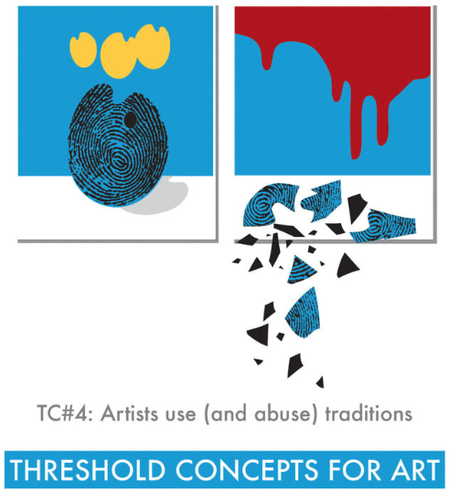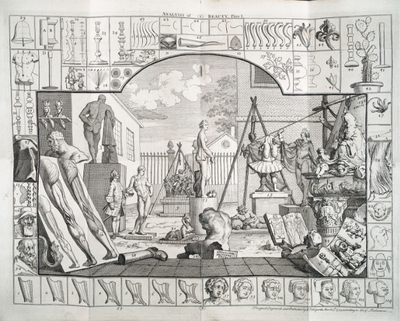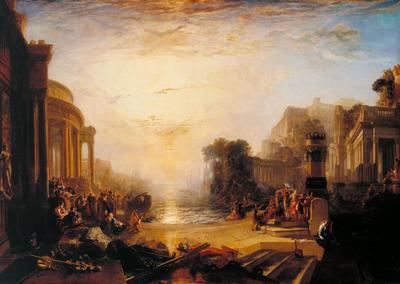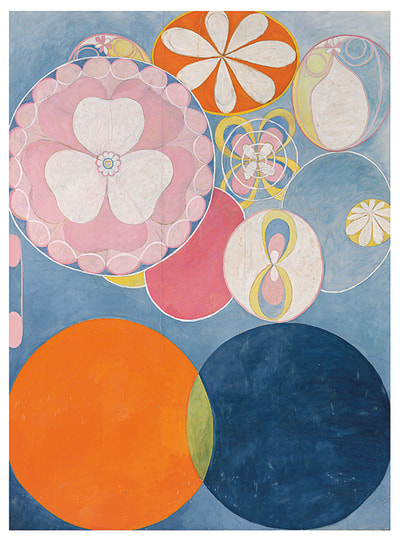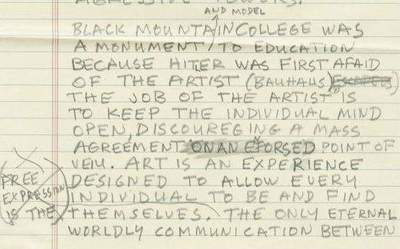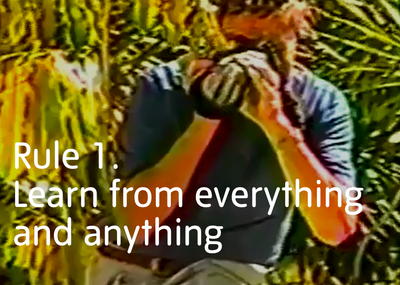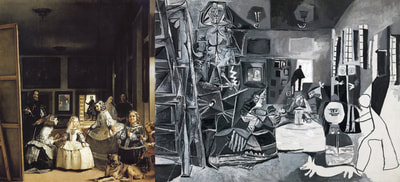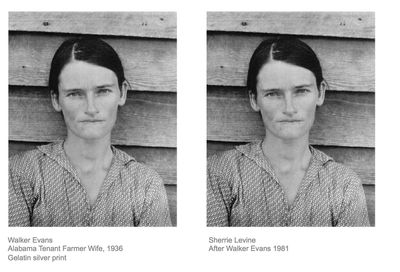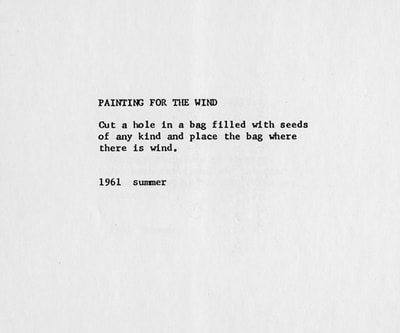TC#4Artists learn the ‘rules’ and conventions so they can decide when to break them. Some artists work within established traditions and genres, others tease and disrupt these in alternative ways. Definitions of art are always changing.
About the graphicOur Threshold Concepts for Art are accompanied with illustrations to aid their introduction. Each image contains a reoccurring graphic: a fingerprint in the shape of an artist's palette. In TC#4, the palette becomes a vase holding a bunch of palette shaped flowers - a traditional still life subject. Think Dutch flower painting or Van Gogh's sunflowers. In a dramatic transformation, the vase is smashed and fragmented, blood (or is that just red paint?) is spilled on the walls. A revolution in seeing has occurred and the 'rules' have been broken.
|
"What has pleased, and continues to please, is likely to please again: hence are derived the rules of art, and on this immoveable foundation they must ever stand."
JosHua Reynolds
How might the artworks above connect to our TC#4 graphic? Alternatively, what connections might be made between these 3 different images? Do these 3 artworks represent particular traditions? Which example of work appears the most radical and why?
“There are no rules. That is how art is born, how breakthroughs happen. Go against the rules or ignore the rules. That is what invention is about.”
HELEN FRANKENTHALER
WhAT DO I NEED TO KNOW?
- Each culture has developed its own 'rules' or conventions of art. These reflect the development of artistic practice in particular locations at particular times. For example, during the early 1500s in Italy, an interest in Classical civilisations prompted artists to develop theories in an attempt to raise the status of their profession. Ideas about perspective, proportion and the ideal human form helped to promote an attempt to create naturalistic depictions of space on a two dimensional surface. A very different attitude to space and time can be seen in far Eastern artistic traditions. A distinctive Japanese convention is to depict the changing of the seasons, from spring to summer to autumn to winter, in one painting. Academies of art are designed to improve the professional standing of artists and often result in the formation of 'rules' or hierarchies of types of art. In the 17th century, for example, narrative paintings of classical or religious subjects (called History Paintings) were considered of higher status than still life paintings or portraits. Holland was one of the first countries to challenge this idea, developing a new market for genre painting. The early 20th century saw a series of political, cultural, technological and artistic revolutions that resulted in the rejection of 'rules' and traditions in order to shape a new reality. Picasso and Braque's Cubist rejection of single point perspective, the anti-art of the Dadaists, the dynamism of the Futurists, the attempt to depict dreamscapes by the Surrealists, are all examples of artists who chose to rebel against existing artistic conventions in order to find a visual language more appropriate to the times in which they were living.
- Artists working in one culture, with one set of 'rules' about how to depict reality, can often influence artists in other cultures to reject or adapt their own 'rules'. Impressionist painters were influenced by Japanese woodblock prints. The relative flatness of Japanese landscapes prompted the French painters to experiment with space and surface in new ways. Much has been written about the influence of African and Oceanic art on modern European artists. The Internet has created a global art culture in which ideas travel across the world, creating cultural exchanges and challenging the relevance of 'rules' or conventions. Anything goes.
- Artists attempt to communicate their vision of the world to others. 'Rules' or conventions can provide a really useful structure or set of expectations for both artist and viewer. They can help create visual conversations over time. During the Middle Ages in Europe, when painters (artists) and stonemasons (craftspeople) were of equal status, the role of tradition was quite strong. As artists began to professionalise, trading their work in a newly emerging marketplace, more emphasis was placed on originality of expression. It was the artist's distinctive style that generated reputation and value. The histories of art can be seen as stories about the friction between tradition and innovation, convention and originality.
- There is often a link made between tradition and skill. Do we still expect artists to be able to make naturalistic representations of 3D objects on a 2D surface? What is the role of skill in art in the age of the Internet and computer technologies? Some critics of modern art point to its lack of skill or quality and we've all heard someone say, about an abstract painting, "My 5 year old could have done that." Contemporary artists often reject technical skill as a measure of the quality of an art work, preferring to emphasise the quality of the idea or concept. However, consider the amount of technical skill required to manufacture and install this sculpture.
Below is an introductory slideshow to encourage initial reflections and discussion:
Practical ideas for the classroom
- Select a famous work of art, something you associate with tradition. Adapt this work of art in any way you like. This is sometimes called appropriation.
- Make a list of all the 'rules' or conventions you associate with making and/or looking at art.
- Sculptures should be made from tough materials and last a long time
- A portrait should be a recognisable image of a person
- Complimentary colours look best together
- Design a set of instructions for another artist.
You might want to take a look at Hans Ulruch Obrist's book/website Do It. You could also check out John Baldessari's famous list of art assignments from 1970. Your instructions will be like a set of rules for making a work of art. You might want to base them on the way you like to work, so that your intended recipient ends up working like you. Alternatively, you might want to imagine a set of instructions that causes another artist to make something totally unlike your own work.
Think carefully about how you present the instructions - a list, a drawing (like Erwin Wurm's One Minute Sculptures instructions), a story...etc. Also, consider how you might do this with a group of other artists, sharing the responses after they are completed. How will you decide who owns what? Can an instruction itself be a work of art?
Follow the links in the images above to find out more about these works and their connections to ideas of appropriation and instruction.
“Learn the rules like a pro, so you can break them like an artist.”
Pablo Picasso
FURTHER READING
The following texts have been chosen to promote wider contextual study. Students should consider the author's intentions, their chosen writing style, and how the texts combine research and historical facts alongside personal insights and opinions.
- Tradition and Innovation in Modern Painting
- Think Like An Artist by Will Gompertz
- Draw it with your eyes closed: The art of the art assignment (blog and book)

